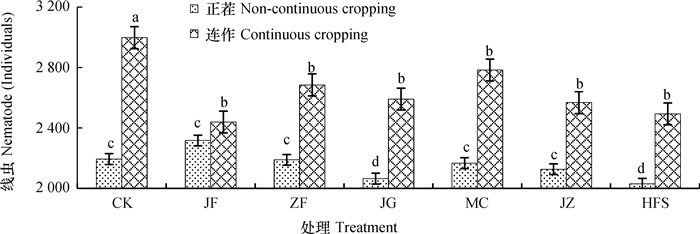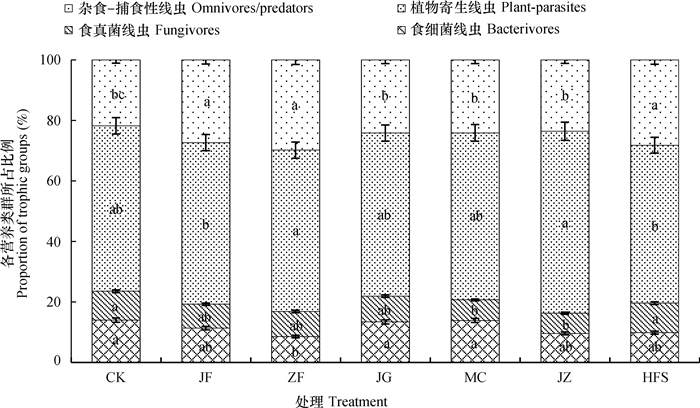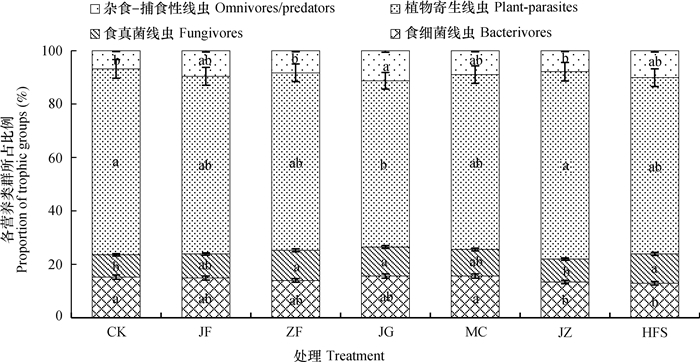大豆胞囊线虫是引起大豆胞囊线虫病的病原,典型的定居型内寄生土传性线虫。在大豆生长季节里,大豆胞囊线虫在东北地区一年发生3~4代。苗期是影响大豆胞囊线虫最终群体量的关键时期[1-2],此时若有大量线虫侵入根内,将直接影响大豆生长发育。在土壤线虫生物多样性的研究过程中,大豆胞囊线虫应作为关键属种对土壤健康起重要的指示作用,而且土壤线虫作为指示土壤质量或健康的敏感指标近年来已被广泛接受。
国内外就有机肥影响连作大豆土壤线虫群落结构变化和减轻连作障碍的作用已经有许多报道[3-5]。研究表明,土壤线虫对不同肥料能够产生不同的响应[6-7]。线虫群落结构的变化与土壤碱解氮、有机质等养分含量变化有密切联系[8]。长期施用化肥导致土壤结构退化、有机质含量下降、土壤微生物多样性和生物活性降低、土壤微生物群落代谢功能下降[9-10],不利于农业可持续发展。有机物料还田作为提高农田土壤有机质水平的主要来源途径,是改善土壤理化性质、优化土壤生物群落结构、综合提高土壤地力和生态功能的关键调控因子[11-14]。试验还表明有机肥的施用能够增加土壤线虫总数[3, 5, 15-16],提高土壤食细菌线虫、食真菌线虫[3, 15, 17-18]和杂食-捕食性线虫的数量,降低植物寄生线虫的数量[15, 17],从而对土壤微生物区系健康环境的构建有促进作用。有机肥的施用能够增加土壤有益线虫的数量[19]。因此,探究以有机物料为主的能够抑制大豆连作过程中土传病害和维护土壤健康的有机肥料迫在眉睫。
近年来,随着种植结构的调整,大豆越来越受到关注,但结合大豆连作出现根际土壤线虫引起病害的实际情况,关于不同有机物料对线虫大量增长的抑制作用的研究相对较少。本研究在连作体系下通过大豆根际土壤线虫群落结构的差异性变化,研究以农业废弃物为主的有机物料对线虫群落结构的影响。比较不同种类的有机物料对连作大豆的土壤肥力及线虫群落结构的调控差异,以及减轻乃至消除大豆连作过程中胞囊线虫病及土传病害发生的作用,为大豆连续种植提供相关参考。
1 材料与方法 1.1 研究区概况试验于吉林农业大学教学实验田进行。气候类型属亚欧大陆半干燥半湿润季风气侯类型。10 ℃以上年积温2 950~3 500 ℃,年降水量600 mm左右,6—8月的降水总量有350~400 mm,占全年降水的60%以上。无霜期145 d左右,昼夜温差较大,秋短春长。土壤类型为黑土,试验前供试耕层土壤及各有机物料处理基本性质见表 1。
|
|
表 1 土壤及各有机物料基本性质 Table 1 Basic properties of the soil and organic manures |
本试验为小区试验,设正茬和连作两个主处理,7个副处理,分别为:空白对照(CK);鸡粪(JF);猪粪(ZF);秸秆(JG);牧草(MC);菌渣(JZ);黄腐酸生物有机肥(HFS)。试验设3次重复,共42个小区。正茬小区此前未种植过大豆。连作小区起始于2010年,为长期定位试验。小区面积25 m2,每小区8垄,垄距0.65 m,垄长5 m。CK处理不施用有机物料,其余处理每垄施入相当于烘干重0.75 kg的不同有机物料。有机物料采用垄沟沟底施用,覆盖薄土压实后种植。所有小区施磷酸二铵60 g、氯化钾45 g。大豆品种为吉农18。鸡粪、猪粪,均取自吉林农业大学动物科学与技术学院;牧草取自内蒙古扎赉特旗牧场;黄腐酸生物有机肥取自山东泉林嘉有肥料有限责任公司;其余均取自吉林农业大学培养场。
1.3 研究方法2016年9月大豆收获时进行土样采集。根际土壤用抖根法[20]采集;每小区随机选取10点采样,混合后迅速装入自封袋编号,部分置于实验室4 ℃冰箱保存,部分风干磨碎后测定土壤理化性质。土壤pH、有机质、碱解氮和微生物生物量碳氮均采用常规方法测定。
另称取新鲜土壤50 g,采用浅盘法分离土壤中的线虫[21],解剖镜下计算数量,然后随机抽取100条左右在光学显微镜下鉴定到属。线虫鉴定参考文献[22-23]。将线虫分为四个营养类群:食细菌线虫(Bacterivores)、食真菌线虫(Fungivores)、植物寄生线虫(Plant-parasites)和杂食-捕食性线虫(Omnivores/predators)[24]。
对土壤线虫的多样性和群落结构进行评价,具体计算方法如下:
(1)自由生活线虫成熟指数(MI)[25]
| $ {\rm{MI = }}\sum {\rm{c}}-{{\rm{p}}_{\rm{i}}} \times {{\rm{p}}_{\rm{i}}}\left( {仅包括自由生活线虫} \right) $ |
式中,pi为第i个分类单元中个体占线虫总个体数量的比例;c-pi为赋予某一种类线虫的cp值,cp值是Bongers[23]根据线虫不同的生活史策略,将陆地和淡水生活的线虫划分为r-对策者向k-对策者过渡的5个类群。
(2)植食性线虫成熟指数(PPI)[25]
| $ {\rm{PPI = }}\sum {\rm{c}}-{{\rm{p}}_{\rm{i}}} \times {{\rm{p}}_{\rm{i}}}\left( {仅包括植物寄生线虫} \right) $ |
(3)线虫通路比值(NCR)[26]
| $ {\rm{NCR}} = {\rm{BF/}}\left( {{\rm{BF}} + {\rm{FF}}} \right) $ |
式中,BF为食细菌线虫的数量;FF为食真菌线虫的数量。
(4)富集指数(EI)
| $ {\rm{EI}} = 100 \times \left( {{\rm{e/}}\left( {{\rm{e + b}}} \right)} \right) $ [27] |
式中,b代表食物网中的基础成分;e代表食物网中的富集成分。
(5)优势度指数(λ)[28]
| $ \lambda = \sum {{{\rm{p}}_{\rm{i}}}^2} $ |
土壤线虫数量折算成每100 g干土含有线虫的条数;丰度以不同属或营养类群的线虫数量占线虫总数的百分比(%)来表示;采用SPSS 23.0软件进行LSD检验和单因子、双因子方差分析。
2 结果 2.1 不同有机物料对土壤性质的影响方差分析表明,正茬土壤的pH、碱解氮、有机质和微生物生物量氮均显著高于连作7年的土壤,土壤含水量、碱解氮和土壤呼吸则显著低于连作7年土壤,而有效磷、速效钾则呈现有增有减的现象(图 1);施用有机物料对含水量没有显著影响,却显著增加土壤中碱解氮和微生物生物量氮含量(图 1)。与CK相比,有机物料能显著提高土壤碱解氮、有机质和微生物生物量碳含量(图 1)。

|
图 1 不同有机物料处理根际土壤性质 Fig. 1 Physico-chemical properties of the rhizosphere soil relative to organic manure applied 注:1)CK,空白对照;JF,鸡粪;ZF,猪粪;JG,秸秆;MC,牧草;JZ,菌渣;HFS,黄腐酸生物有机肥。2)误差线为标准偏差。3)同一柱形字母不同表示差异显著(p<0.05)。下同 Note:1) CK, chemical fertilizer; JF, chicken dropping; ZF, pig dung; JG, crop stalks; MC, forage grass; JZ, mushroom residue; HFS, fulvic acid bio-manure. 2)Error bars represent standard deviation. 3)Different letters in the same column represent significant difference at 0.05 level. The same below |
方差分析表明,施用有机物料的处理线虫总数显著高于对照组(图 2);作物和施肥的交互作用对线虫总数的影响显著(p<0.05)。大豆根际每100 g干土线虫数量范围正茬在2 031~2 317条,连作2 439~2 998条,连作大豆土壤根际线虫总数明显高于正茬土壤。正茬土壤,除鸡粪处理根际土壤线虫略高于CK外,其余所有处理的线虫总量均低于对照,黄腐酸生物有机肥的作用效果最明显,较对照相比降低7.43%。连作土壤,所有有机物料处理线虫数量均明显低于对照,鸡粪效果最为明显,其次为黄腐酸生物有机肥,分别降低19.65%和16.84%,两者较对照均达到显著性差异(p<0.05)。在大豆连作7年过程中,CK处理土壤中线虫数量上升了36.65%,所有有机物料处理增幅均明显小于CK处理,施用鸡粪处理仅增长5.27%,其次为菌渣处理增长20.73%。

|
图 2 不同有机物料对线虫总数的影响 Fig. 2 Effect of organic manure on total number of the nematodes in the rhizosphere soil relative to type of the manure |
本研究共鉴定出大豆根际土壤线虫30属。其中,食细菌线虫8属,食真菌线虫3属,植物寄生线虫16属,杂食-捕食性线虫3属。螺旋线虫属和孔咽线虫属为大豆田的优势菌属,而螺旋线虫属为绝对优势菌属,平均所占比例正茬为24.11%,连作为29.24%;孢囊线虫属、真头叶线虫属、板唇线虫属为亚优势菌属;其他为常见属和一般属。
正茬大豆根际主要线虫优势属(个体数占土壤线虫群落个体总数10%以上)为盘旋线虫属和孔咽线虫属;连作大豆根际主要线虫优势属为真滑刃线虫属、螺旋线虫属和胞囊线虫属。其中,胞囊线虫属虽为两种种植年限共同的线虫优势属,但在连作土壤中的丰度(平均34.1%)高于正茬(平均29.0%)。
由表 2可以看出,正茬土壤中食细菌线虫占线虫总量的10%左右,各施肥处理间差异不明显。CK处理所占比例最高为13.98%,所有有机物料处理所占比例均低于对照。连作土壤中食细菌线虫所占的比例较正茬呈明显上升趋势。猪粪处理增加最明显,上升了64.08%,其次是菌渣处理增加40.06%,其余各有机物料处理增长幅度均低于对照。在连作土壤中CK处理中食细菌线虫占15.24%,有机物料处理明显低于CK处理。
|
|
表 2 不同有机物料对根际土壤食细菌线虫群落结构、cp值、相对丰度与优势度的影响 Table 2 Effects of organic manure on community structure, cp value, relative abundance and dominance of the soil bacteria feeding nematodes in the rhizosphere soil relative to type of the manure |
不同有机物料对食真菌线虫的影响也各不相同。所有施肥处理的连作土壤较正茬相比茎线虫属类线虫相对丰度下降明显,在正茬土壤中各施肥处理均为常见菌属,连作7年土壤中变为一般均属。CK处理下降91.48%,除黄腐酸生物有机肥外,其余各处理的下降幅度均小于对照,牧草处理下降90.54%,下降幅度最小。所有施肥处理连作土壤中线虫丰度较正茬相比均有不同程度的增加,不同菌属的增加幅度不同。食真菌线虫在正茬土壤中所占比例较小,各施肥处理相对丰度无明显差异,黄腐酸生物有机肥处理相对丰度最高9.77%,其次为CK,占9.53%;连作土壤中食真菌线虫相对丰度在6.79%~9.73%之间,CK处理相对丰度最高,占线虫总数的12.34%。随着大豆种植年限的增加,土壤中食真菌线虫丰度也在上升,占8.59%~12.34%,而有机物料处理无论正茬还是连作食真菌线虫所占比例均低于对照。
不同有机物料对植物寄生线虫影响也各有差异(表 4)。螺旋虫属相对丰度,在正茬和连作土壤中各施肥处理间均无明显差异,连作土壤较正茬土壤略有上升,上升幅度在9.32%~31.57%之间。拟盘旋线虫属相对丰度,在大豆连作过程中也有略微上升。孢囊线虫属,正茬土壤中各处理间也无明显差异,相对丰度在26.98%~32.65%之间。连作土壤中菌渣处理中孢囊线虫属相对丰度值最高,达36.69%,其次为鸡粪和猪粪处理均为34.75%。鸡粪处理在连作过程中增加最明显,上升25.91%,增加最少的为猪粪处理,提高2.10%。垫刃线虫属、丝尾垫刃线虫属、具脊垫刃线虫属在连作土壤中相对丰度较正茬土壤均有略微上升,但在正茬和连作土壤中丰度值较小。纽带线虫属、针线虫属、剑线虫属、叉叶线虫属在正茬土壤中未发现,但在连作土壤中出现,并表现为一般菌属。拟盘线虫属,在正茬和连作土壤中均为一般菌属,在连续种植过程中丰度略有下降。盾线虫属、平滑垫刃线虫属相对丰度在连作过程中呈下降趋势,并且正茬和连作间均无明显差异。盘旋线虫属、小环线虫属、杆垫刃线虫属在正茬土壤植物寄生线虫中相对丰度较小,在连作土壤中未发现。在大豆连作过程中土壤中植物寄生线虫丰度总体呈上升趋势,各处理的增长幅度不同。其中黄腐酸生物有机肥处理增加最明显,提高26.37%,其次为鸡粪处理提高24.35%。
|
|
表 3 不同有机物料对根际土壤食真菌线虫群落结构、cp值、相对丰度与优势度的影响 Table 3 Effects of organic manure on community structure, cp value, relative abundance and dominance of the fungi-feeding nematode in the rhizosphere soil relative to type of the manure |
|
|
表 4 不同有机物料对根际土壤植物寄生线虫群落结构、cp值、相对丰度与优势度的影响 Table 4 Effects of organic materials on community structure, cp value, aelative abundance and dominance of theplant parasitic nematodes in the rhizosphere soil relative to type of the manure |
正茬土壤中杂食-捕食性线虫丰度占各处理线虫总数的20%左右,各施肥处理间存在一定差异。正茬土壤中孔咽线虫属相对丰度值在19.73%~28.12%之间。但随着连作年限的增加,丰度值下降趋势非常显著,由优势菌属变为亚优势菌属。正茬土壤中黄腐酸生物有机肥处理相对丰度值为28.18%,在所有处理中最高,猪粪处理最低,为19.77%。连作土壤中黄腐酸生物有机肥处理丰度值最高10.10%。各施肥处理较正茬相比均有明显的下降,CK处理下降幅度达68.60%,为所有处理中最高。
本研究中,cp值为2和3的线虫群体占主体地位,多存在于食真菌线虫和植物寄生线虫营养类群之中;cp值为1和4的线虫群体次之,多存在于食细菌线虫和植食-捕食性线虫营养类群中;cp值为5的线虫群体最少,仅有一种。本研究中的关键属种cp值均为3,说明线虫繁殖和抗干扰能力比较强。
综上所述,大豆种植过程中无论是正茬还是连作,土壤中不同属的线虫因施入的物料不同而响应不同,在线虫总量中所占的比例也不同。在大豆连作过程中,食细菌线虫种类较多,相对丰度略有上升。食真菌线虫种类相对较少,在线虫总量中所占的比例有所提高。植物寄生线虫种类最多,在线虫总量中所占比例超过50%,杂食-捕食性线虫所占比例明显下降,有机物料对平衡土壤中线虫比例作用明显。
|
|
表 5 不同有机物料对根际土壤杂食-捕食性线虫群落结构、cp值、相对丰度与优势度的影响 Table 5 Effects of organic manure on community structure, cp value, relative abundance and dominance of the omnivorous -predatory bacteria nematodes in the rhizosphere soil relative to type of the manure |
由图 3可以看出,连作土壤中食细菌线虫所占比例并不高,CK处理的食细菌线虫占比例最高15.24%。所有有机物料处理在12.89%~15.73%之间,均低于对照。各处理间无明显差异。食真菌线虫CK处理所占比例最高为12.34%,所有有机物料处理均低于CK处理。各处理间无明显差异。植物寄生线虫占线虫总数的1/2以上,菌渣处理最多占70.03%,CK最少占39.58%。杂食-捕食性线虫占线虫总数的比例最小。

|
图 3 不同有机物料对正茬大豆根际土壤线虫营养类群比例的影响 Fig. 3 Effects of organic manure on proportion of trophic groups of soil nematodes in the rhizosphere of soybean relative to type of the manure 注:不同英文字母表示相同营养类群在不同处理间差异显著(p < 0.05)。下同 Note: Different letters indicate significant difference between treatments the same in trophic group at 0.05 level. The same below |
由图 4可以看出,在连作土壤中所有处理的食细菌线虫所占线虫总量的12.89%~15.63%之间,与食真菌线虫间无显著差异,与植物寄生线虫间差异极显著,与杂食-捕食性线虫之间差异也比较明显。食真菌线虫在个营养类群中所占比例较小,CK处理最高12.34%,菌渣最低8.59%,各施肥处理间无明显差异。植物寄生线虫在营养类群中占比例最高,CK除外所有处理所占比例均超过60%,菌渣处理最高可达70.03%,各有机物料处理间差异不显著。

|
图 4 不同有机物料对连作大豆根际土壤线虫营养类群比例的影响 Fig. 4 Effects of organic manure on proportion of trophic groups of nematodes in rhizosphere soils under continuous cropping of soybean relative to type of the manure |
综上所述,无论是正茬还是连作土壤中大豆根际土壤线虫营养类群对不同有机物料有不同的响应。随着种植年限的增加,食细菌线虫所占比例有所上升,但所有施肥处理均无明显上升,上升幅度最大的为CK处理5.12%,食真菌线虫所占比例也略有上升,植物寄生线虫所占比例也有一定程度的上升,鸡粪处理上升12.99%,表现最明显。其次为牧草,上升10.21%,最少的是猪粪处理,上升4.04%。杂食-捕食性线虫所占比例显著下降,黄腐酸生物有机肥处理下降17.88%,下降最明显。
2.5 不同有机物料对土壤线虫生态指数的影响方差分析表明连作大豆根际自由生活线虫成熟指数(MI)、植物寄生线虫成熟指数(PPI)、线虫通路比值(NC)、优势度指数(λ)均显著高于正茬根际(p<0.001),富集指数(EI)显著低正茬根际(p<0.001)。施肥与作物的交互作用对NCR、EI、λ影响显著,对MI和PPI影响不显著(p<0.05)。正茬的MI、PPI、NCR、EI各施肥处理间无显著差异,所有有机物料处理λ显著高于CK(p<0.05)。连作的MI、PPI、NCR各施肥处理间无显著差异,所有有机物料处理EI、λ显著高于CK(p<0.05)。
|
|
表 6 不同有机物料处理土壤线虫生态指标 Table 6 Ecological indices of soil nematodes in the rhizosphere soil relative to type of the manure applied |
有机物料对正茬和连作大豆土壤中碱解氮、有效磷、有机质等土壤养分含量有明显的提高作用,对土壤微生物学特征也有明显的改善,效果明显好于单施化肥。这与陈安强[29]、王芳[30]等化肥与不同有机物料配合施用,土壤微生物学特性(微生物生物量碳、微生物生物量氮、土壤呼吸、脲酶、碱性磷酸酶)以及部分土壤养分状况(全氮、有效磷、速效钾、阳离子交换量)较单施化肥处理有进一步改善的研究结果一致。与宋蒙亚等[31]长期施用有机物料能够有效调控土壤微生物群落的功能和结构,改善土壤质量研究结果一致。就土壤结构而言,虽然添加有机物料较单施化肥相比土壤养分有了明显的提高,但不同有机物料之间对连作大豆土壤养分的提高效果也存在一定的差异,这可能与有机物料养分释放周期和峰值有关,也可能是由于大豆根系分泌物与不同有机物料之间的响应不同造成的。
本研究结果表明,有机物料对减缓大豆连作过程土壤中孢囊线虫数量的显著增加具有一定的效果,不同类型孢囊线虫对不同类型有机物料的响应也有所不同。在大豆连作过程中,食细菌线虫种类较多,相对丰度略有上升。食真菌线虫种类相对较少,在线虫总量中所占的比例有所提高。植物寄生线虫种类最多,在线虫总量中所占比例超过50%,杂食-捕食性线虫所占比例明显下降,有机物料对平衡土壤中线虫比例作用明显;对缓解连作大豆土壤中食细菌线虫、食真菌线虫、植物寄生线虫占线虫总量中所比例的增加,杂食-捕食性线虫的显著减少作用明显。这与林琳等[32]不同施肥对土壤线虫群落组成、结构及多样性均产生一定影响的结论一致。由于大豆孢囊线虫对寄主的强专化性,大豆连作过程中会出现优势菌属相对丰度不断增加,而常见菌属、一般均属相对丰度不断下降,甚至消失,群落结构复杂性降低,土壤线虫群落结构稳定性下降,导致连作大豆病害加重的现象。王雪峰等[33]研究发现,大豆根际效应增加土壤线虫的丰度,但降低了线虫群落结构的复杂性;王进闯等[34]认为线虫的物种丰富度随着连作年限的增加呈逐渐降低的趋势,这与本研究结果一致。而王雪峰等[35]认为施用化肥能够抑制植物寄生线虫但提高食细菌和食真菌线虫在线虫总数中的比例,与本研究结论有所不同,这可能是由于气候和种植作物不同造成的。靳学慧等[36]报道长期轮作使土壤中胞囊数量减少,连作使土壤中胞囊数量增加至14年后趋于平衡。张俊华和郑国琦[37]认为土壤碱解氮与线虫总数呈显著正相关; 速效钾与线虫多个生态指数均呈显著负相关。本研究发现,无论正茬还是连作土壤中,线虫总数与碱解氮含量均呈正相关关系,与其研究结果一致,但本研究未发现土壤中速效钾含量与生态指数有明显的相关性,这可能是由于连作的年限不同所致。陈井升等[38]认为,在发生大豆胞囊线虫病的任何地块,大豆胞囊线虫都是混合群体,不存在单一生理小种,仅是某个生理小种占优势。因此,研究大豆连作过程中不同有机物料对土壤中胞囊线虫数量的影响有着重要的意义,尤其要明确何种有机物料更有效地平衡连作过程中大豆孢囊线虫相对数量,降低大豆胞囊线虫的危害。
优势属种的变化决定了群落结构的变化,而关键属种的变化决定了病害发生程度和对土壤健康状况的指示作用,因此,土壤线虫作为有效的生物指示剂能够很好的指示土壤的健康状况,尤其优势营养类群、优势属种和关键属种的指示作用更为明显。
4 结论有机物料能提高正茬和连作土壤中微生物生物量碳、微生物生物量氮以及土壤养分含量,有效改善土壤呼吸。正茬和连作两种种植年限的有机物料处理效果均好于对照。各施肥处理连作土壤线虫数量明显高于正茬,连作处理所有有机物料处理土壤中线虫总量均低于对照,各施肥处理间差异比较明显。有机物料可以有效控制大豆连续种植过程土壤中优势属的变化从而控制土壤中土壤中线虫总数的变化,还可以降低关键属种的种群丰度,减少病害类型,减轻病害程度。有机物料可以抑制连作大豆土壤中植物寄生线虫占线虫营养类群比例的大幅增长,减少杂食-捕食性线虫所占比例的下降,保持大豆连作土壤中各营养类群比例平衡,减少土传病害的发生,维持土壤健康。
| [1] |
陈立杰, 朱艳, 刘彬, 等. 连作和轮作对大豆胞囊线虫群体数量及土壤线虫群落结构的影响. 植物保护学报, 2007, 34(4): 347-352. Chen L J, Zhu Y, Liu B, et al. Influence of continuous cropping and rotation on soybean cyst nematode and soil nematode community structure (In Chinese). Acta Phytophylacica Sinica, 2007, 34(4): 347-352. (  0) 0) |
| [2] |
宋美静, 朱晓峰, 王东, 等. 我国大豆主产区大豆胞囊线虫群体分布及致病性分化研究. 大豆科学, 2016, 35(4): 630-635. Song M J, Zhu X F, Wang D, et al. Population distribution and pathogenicity differentiation of soybean cyst nema-tode in main soybean production areas of China (In Chinese). Soybean Science, 2016, 35(4): 630-635. (  0) 0) |
| [3] |
Liang W J, Lou Y, Li Q, et al. Nematode faunal response to long-term application of nitrogen fertilizer and organic manure in Northeast China . Soil Biology & Biochemistry, 2009, 41(5): 883-890.
(  0) 0) |
| [4] |
胡诚, 曹志平, 齐迎春, 等. 土壤线虫群落对施用EM生物有机肥的响应. 生态学报, 2010, 30(18): 5012-5021. Hu C, Cao Z P, Qi Y C, et al. Response of soil nematode community to multi-year application of EM(effective microorganism)biological-orgainc manure (In Chinese). Acta Ecologica Sinica, 2010, 30(18): 5012-5021. (  0) 0) |
| [5] |
刘艳军, 张喜林, 高中超, 等. 长期施肥对哈尔滨黑土土壤线虫群落的影响. 土壤通报, 2011, 42(5): 1112-1115. Liu Y J, Zhang X L, Gao Z C, et al. Effect of long-term fertilizer on soil nematode communities in Harbin black soil area (In Chinese). Chinese Journal of Soil Science, 2011, 42(5): 1112-1115. (  0) 0) |
| [6] |
Hu C, Qi Y C. Effect of compost and chemical fertilizeron soil nematode community in a Chinese maize field . European Journal of Soil Biology, 2010, 46: 230-236. DOI:10.1016/j.ejsobi.2010.04.002
(  0) 0) |
| [7] |
Wei C Z, Zheng H F, Li Q, et al. Nitrogen additionregulates soil nematode community composition throughammonium suppression . PLoS One, 2012. DOI:10.1371/journal.pone.0043384
(  0) 0) |
| [8] |
Kamlesh J, William B, Whitman LM, et al. Progressive and retrogressive ecosystem development coincide with soil bacterial community change in a dune system under lowland temperate rainforest in New Zealand . Plant and Soil, 2013, 367: 235-247. DOI:10.1007/s11104-013-1720-2
(  0) 0) |
| [9] |
Guo J H, Liu X J, Zhang Y, et al. Significant acidification in major Chinese croplands . Science, 2010, 327(5968): 1008-1010. DOI:10.1126/science.1182570
(  0) 0) |
| [10] |
刘晶鑫, 迟凤琴, 许修宏, 等. 长期施肥对农田黑土微生物群落功能多样性的影响. 应用生态学报, 2015, 26(10): 3066-3072. Liu J X, Chi F Q, Xu X H, et al. The effects of long-term fertilization on the functional diversity of microbiome in the field (In Chinese). Journal of Applied Ecology, 2015, 26(10): 3066-3072. (  0) 0) |
| [11] |
袁嫚嫚, 刘勤, 张少磊, 等. 太湖地区稻田绿肥固氮量及绿肥还田对水稻产量和稻田土壤氮素特征的影响. 土壤学报, 2011, 48(4): 797-803. Yuan M M, Liu Q, Zhang S L, et al. The effect of green fertilizer nitrogen and green fertilizer in Taihu area on rice yield and soil nitrogen characteristics of paddy fields (In Chinese). Acta Pedologica Sinica, 2011, 48(4): 797-803. DOI:10.11766/trxb200910270484 (  0) 0) |
| [12] |
马超, 周静, 刘满强, 等. 秸秆促腐还田对土壤养分及活性有机碳的影响. 土壤学报, 2013, 50(5): 915-921. Ma C, Zhou J, Liu M Q, et al. The effect of the straw on the soil nutrient and the active organic carbon (In Chinese). Acta Pedologica Sinica, 2013, 50(5): 915-921. (  0) 0) |
| [13] |
Turmel M S, Speratti A, Baudron F, et al. Crop residue management and soil health: A systems analysis . Agricultural Systems, 2015, 134: 6-16. DOI:10.1016/j.agsy.2014.05.009
(  0) 0) |
| [14] |
张红, 吕家珑, 曹莹菲, 等. 不同植物秸秆腐解特性与土壤微生物功能多样性研究. 土壤学报, 2014, 51(4): 743-752. Zhang H, Lü J L, Cao Y F, et al. The characteristics of different plant straw and the study of soil microbial function diversity (In Chinese). Acta Pedologica Sinica, 2014, 51(4): 743-752. (  0) 0) |
| [15] |
Trivedi P, Rochester I J, Trivedi C, et al. Soil aggregate size mediates the impacts of cropping regimes on soil carbon and microbial communities . Soil Biology & Biochemistry, 2015, 91: 169-181.
(  0) 0) |
| [16] |
江春, 黄菁华, 李修强, 等. 长期施用有机肥对红壤旱地土壤线虫群落的影响. 土壤学报, 2011, 48(6): 1235-1241. Jiang C, Huang J H, Li X Q, et al. Responses of soil nematoe community to long-term application of organic manure in upland red soil (In Chinese). Acta Pedologica Sinica, 2011, 48(6): 1235-1241. DOI:10.11766/trxb201104010119 (  0) 0) |
| [17] |
Nahar M S, Grewal P S, Miller S A. Differential effects of raw and composted manure on nematode community, and its indicative value for soil microbial, physical and chemical properties . Applied Soil Ecology, 2006, 34(2/3): 140-151.
(  0) 0) |
| [18] |
Villenave C, Saj S, Pablo A L, et al. Influence of long-term organic and mineral fertilization on soil nematofauna when growing Sorghum bicolor in Burkina Faso . Biology and Fertility of Soils, 2010, 46(7): 659-670. DOI:10.1007/s00374-010-0471-y
(  0) 0) |
| [19] |
Tabarant P, Villenave C, Risede J M, et al. Effects of four organic amendments on banana parasitic nematodes and soil nematode communities . Applied Soil Ecology, 2014, 49: 59-67.
(  0) 0) |
| [20] |
Wang X, Zabowski D. Nutrient composition of Douglas-fir rhizosphere and bulk soil solutions . Plant and Soil, 1998, 200(1): 13-20. DOI:10.1023/A:1004240315308
(  0) 0) |
| [21] |
毛小芳, 李辉信, 陈小云, 等. 土壤线虫三种分离方法效率比较. 生态学杂志, 2004, 23(3): 149-151. Mao X F, Li H X, Chen X Y, et al. Extraction efficiency of soil nematodes by different methods (In Chinese). Chinese Journal of Ecology, 2004, 23(3): 149-151. (  0) 0) |
| [22] |
尹文英. 中国土壤动物检索图鉴. 北京: 科学出版社, 1998, 51-89. Yi W Y. Pictorical keys to soil animals of China (In Chinese). Beijing: Science Press, 1998, 51-89. (  0) 0) |
| [23] |
Bongers T. De nematoden van nederland . Utrecht: Foundation Publisher of Royal Dutch Natural History Society, 1994.
(  0) 0) |
| [24] |
李琪, 梁文举, 姜勇. 农田土壤线虫多样性研究现状及展望. 生物多样性, 2007, 15(2): 134-141. Li Q, Liang W J, Jiang Y. Present situation and prospect of soil nematode diversity in farmland ecosystems (In Chinese). Biodiversity Science, 2007, 15(2): 134-141. (  0) 0) |
| [25] |
Bongers T. The maturity index: An ecological measure of environmental disturbance based on nematode species composition . Oecologia, 1990, 83(1): 14-19. DOI:10.1007/BF00324627
(  0) 0) |
| [26] |
Yeates G W. Nematodes as soil indicators: Functional and biodiversity aspects . Biology and Fertility of Soil, 2003, 37(4): 199-210.
(  0) 0) |
| [27] |
Yeates G W. Variation in soil nematode diversity under pasture with soil and year . Soil Biology & Biochemistry, 1984, 16(2): 95-102.
(  0) 0) |
| [28] |
Liang W J, Li Q, Jiang Y, et al. Nematode faunal analysis in an aquic brown soil fertilised with slow-releaseurea, Northeast China . Applied Soil Ecology, 2005, 29: 185-192. DOI:10.1016/j.apsoil.2004.10.004
(  0) 0) |
| [29] |
陈安强, 付斌, 鲁耀, 等. 有机物料输入稻田提高土壤微生物碳氮及可溶性有机碳氮. 农业工程学报, 2015, 31(21): 160-167. Chen A Q, Fu B, Lu Y, et al. Organic materials enter rice fields to improve soil microbial carbon nitrogen and soluble organic carbon nitrogen (In Chinese). Transactions of the Chinese Society of Agricultural Engineering, 2015, 31(21): 160-167. DOI:10.11975/j.issn.1002-6819.2015.21.021 (  0) 0) |
| [30] |
王芳, 张金水, 高鹏程, 等. 不同有机物料培肥对渭北旱塬土壤微生物学特性及土壤肥力的影响. 植物营养与肥料学报, 2011, 17(3): 702-709. Wang F, Zhang J S, Gao P C, et al. Effects of application of different organic materials on soil microbiological properties and soil fertility in Weibei rainfed highland (In Chinese). Plant Nutrition and Fertilizer Science, 2011, 17(3): 702-709. DOI:10.11674/zwyf.2011.0425 (  0) 0) |
| [31] |
宋蒙亚, 李忠佩, 刘明, 等. 不同有机物料组合对土壤养分和生化性状的影响. 中国农业科学, 2013, 46(17): 3594-3603. Song M Y, Li Z P, Liu M, et al. Effects of mixtures of different organic materials on soil nutrient content and soil biochemical characteristics (In Chinese). Scientia Agricultura Sinica, 2013, 46(17): 3594-3603. DOI:10.3864/j.issn.0578-1752.2013.17.008 (  0) 0) |
| [32] |
林琳, 王琳, 张雪萍, 等. 不同施肥处理方式下土壤线虫群落的研究. 国土与自然资源研究, 2013(3): 90-92. Lin L, Wang L, Zhang X P, et al. Study on soil nematode community structure under different fertilization treatment conditions (In Chinese). Territory & Natural Resources Study, 2013(3): 90-92. (  0) 0) |
| [33] |
王雪峰, 毛之夏, 徐济责, 等. 根际效应对大豆田土壤线虫群落组成及多样性的影响. 生态学报, 2016, 36(16): 5256-5262. Wang X F, Mao Z X, Xu J Z, et al. Responses of soil nematode community composition and diversity to rhizosphere effects in a soybean field (In Chinese). Acta Ecologica Sinica, 2016, 36(16): 5256-5262. (  0) 0) |
| [34] |
王进闯, 王敬国. 大豆连作土壤线虫群落结构的影响. 植物营养与肥料学报, 2015, 21(4): 1022-1031. Wang J C, Wang J G. Effects of continuous soybean monoculture on soil nematode community (In Chinese). Journal of Plant Nutrition and Fertilizer, 2015, 21(4): 1022-1031. DOI:10.11674/zwyf.2015.0422 (  0) 0) |
| [35] |
王雪峰, 苏永中, 杨晓, 等. 干旱区沙地长期培肥对土壤线虫群落特征的影响. 中国沙漠, 2011, 31(6): 1416-1422. Wang X F, Su Y Z, Yang X, et al. Responses of soil nematode communities tolong-term fertilization in arid region of China (In Chinese). Journal of Desert Research, 2011, 31(6): 1416-1422. (  0) 0) |
| [36] |
靳学慧, 辛惠普, 郑雯, 等. 长期轮作和连作对土壤中大豆胞囊线虫数量的影响. 中国油料作物学报, 2006, 28(2): 189-193. Jin X H, Xin H P, Zheng W, et al. Long-term rotation and continuous effect on the number of soya cells in the soil (In Chinese). Chinese Journal of Oil Crop Science, 2006, 28(2): 189-193. (  0) 0) |
| [37] |
张俊华, 郑国琦. 宁夏枸杞根际土壤线虫群落特征. 应用生态学报, 2016, 27(5): 1647-1656. Zhang J H, Zheng G Q. Soil nematode community structure in rhizosphere of Lycium barbarum (In Chinese). Chinese Journal of Applied Ecology, 2016, 27(5): 1647-1656. (  0) 0) |
| [38] |
陈井生, 李肖白, 李泽宇, 等. 大豆胞囊线虫生理分化与致病性变异研究进展. 中国农学通报, 2010, 26(12): 261-265. Chen J S, Li X B, Li Z Y, et al. Research progress of soybean cyst nematode(SCN)physiological differentiation and pathogenic differentiation (In Chinese). Chinese Agricultural Science Bulletin, 2010, 26(12): 261-265. (  0) 0) |
 2018, Vol. 55
2018, Vol. 55


